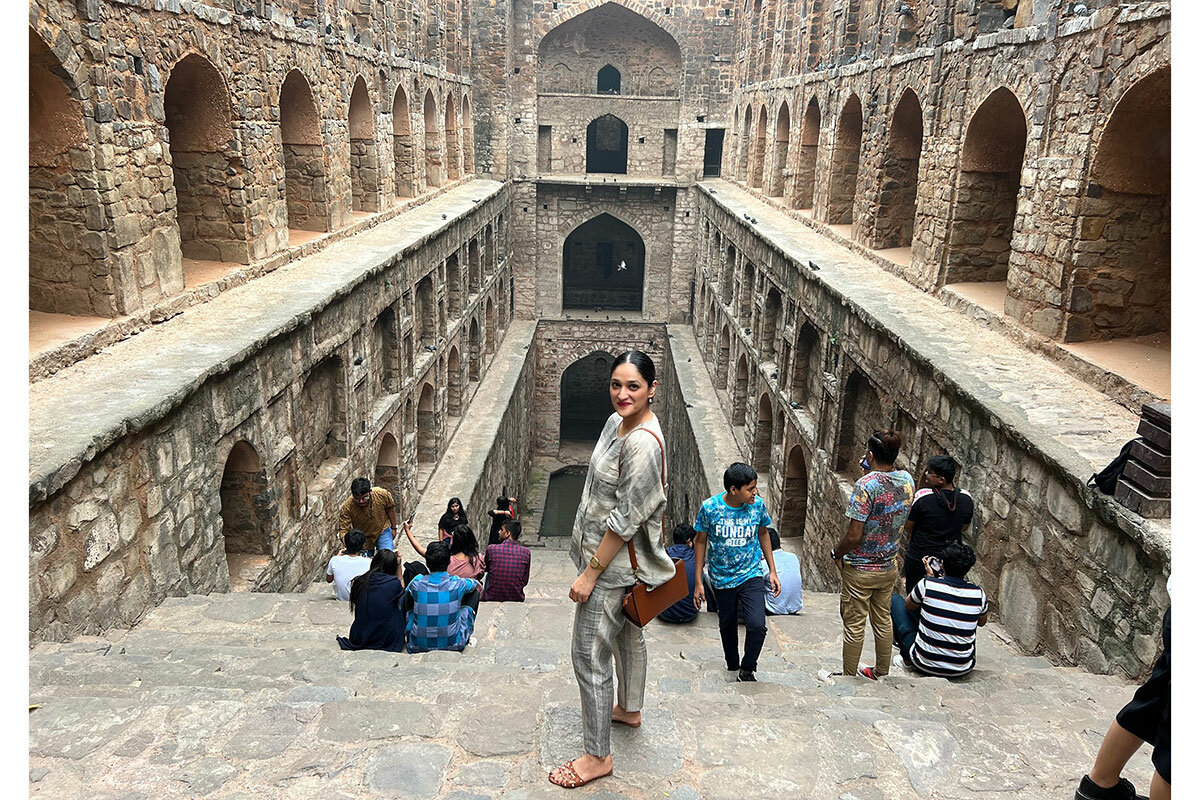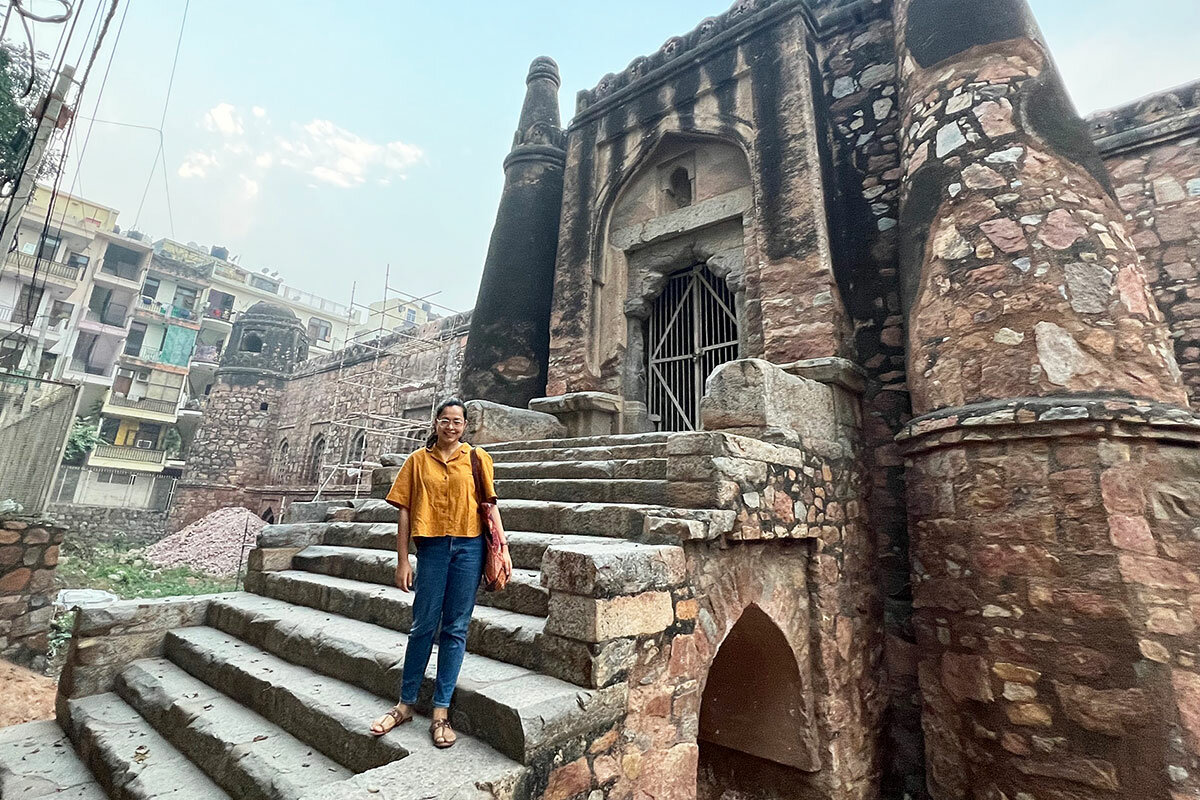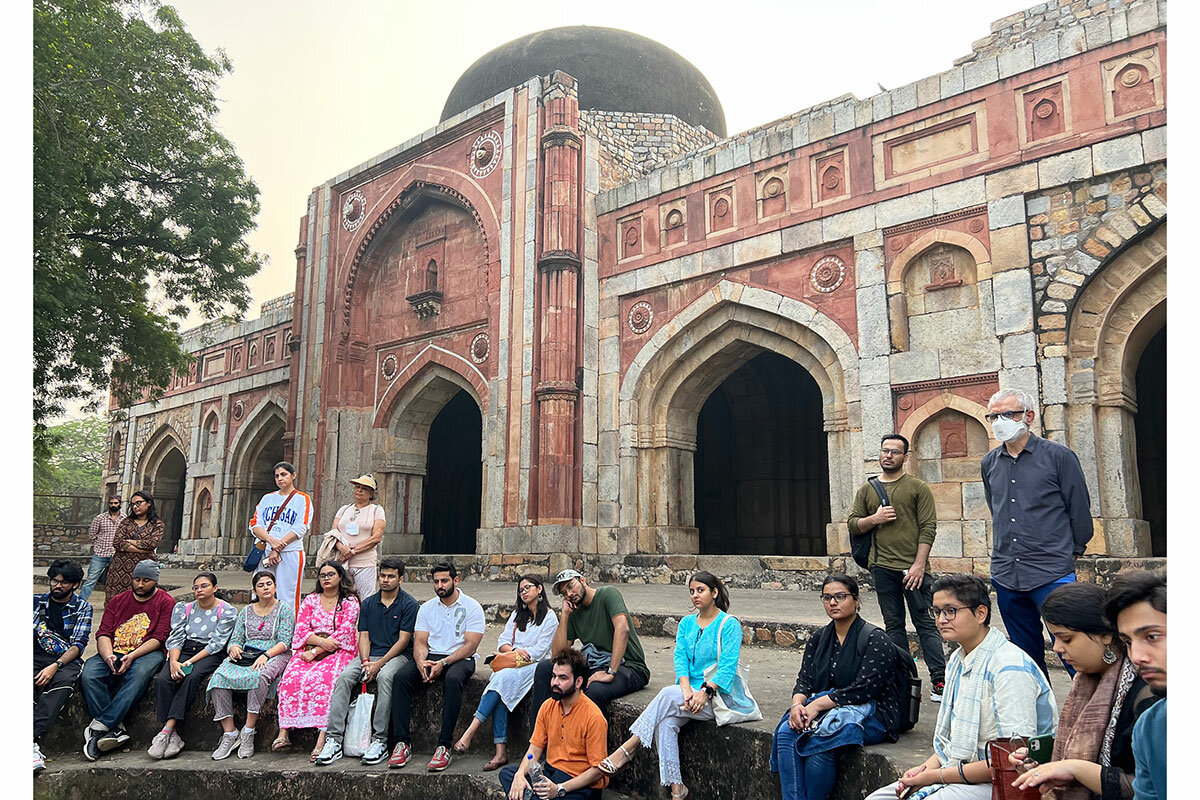As Hindu nationalism grows, so does interest in Delhi’s Muslim history
| New Delhi
Anas Khan pauses outside a 16th-century jewel of an Islamic tomb in the Mehrauli Archaeological Park and draws in his audience.
“Delhi from its beginnings was a city of culture, of unity, and tolerance among many different people. It was a city whose great gift to the world was Urdu,” he tells the group of 35 Delhiites and other Indians. “A beautiful language that took form from the mixing of the Arabic and Farsi and other languages those different people spoke.”
Up to this point, the youthful Delhi historian’s walking tour has been a straight recounting of the origins of the medieval city that would become India’s capital – with a few tales of jinns, or genies, and unrequited royal love thrown in to hold everyone’s interest.
Why We Wrote This
A story focused onIslamophobia in India is rising – but so is interest in Delhi’s historically Muslim neighborhoods, and respect for the capital’s multicultural heritage. For some tour guides and historians, that’s cause for hope.
But now Mr. Khan shifts to the present.
“That Delhi of unity and tolerance is disappearing; we are losing its richness and the lessons it can teach us,” he says. As a few nods spread across his group, he concludes, “I hope you will share some of the stories you heard of our common history and help preserve our heritage for the future.”
Blossoming interest in the city’s roots as a mosaic of cultures and religions – especially among Delhi’s young and cosmopolitan population – can be seen in everything from the newfound “hot” status of historical neighborhoods like Mehrauli to the rising popularity of local history blogs and walking tours like Mr. Khan’s.
Historians and sociologists say the wave of interest is at least in part a response to growing Hindu nationalism, discrimination against the country’s large Muslim minority, and intolerance of “outside” influences. Some argue it signals a shift in how Indians view their history – as something that should be respected, examined, and learned from.
“For a long time, people weren’t interested in history or they buried it as a way to shut out the sad and painful parts of India’s past,” says Aanchal Malhotra, an oral historian who has specialized in chronicling average Indians’ experiences during the country’s 1947 Partition.
“But what we’re seeing now is something different: more people drawn to history as a way to understand how we are a product of many different cultures and influences,” she adds. “To some extent that understanding can help to counter the intolerance and rejection of others we see occurring today.”
Mehrauli calling
That desire to counter rising intolerance and marginalization with the help of history is one reason Zain Patel signed on to the Mehrauli archaeological tour. The young software engineer from Mumbai says he purposely chose to spend a few hours of a work trip to Delhi visiting some of the oldest areas of the city.
“I absolutely think more Indians are wanting to know more about the very old mix of cultures that made us who we are,” he says. “Nationalism and thinking we are the product of one main culture is more prevalent and it’s spreading, but I think knowing the truth about our past is one small way to stand up to the hatred.”
Yet for some skeptics, the small slice of the population with interest in history will never match the large majority who are indifferent and susceptible to alternative versions of Delhi’s heritage.
“If anything, there’s a growing chasm between the small percentage who take an interest in history and value our cultural influences, and the many who just don’t care,” says Ekta Chauhan, an oral historian who focuses on South Delhi’s historical Muslim neighborhoods.
It’s almost certainly no coincidence that one of the focal points of this multicultural heritage boom is Mehrauli, a neighborhood in the south of the capital that hugs the vestiges of Delhi’s first major Islamic constructions, built nearly a millennium ago.
The neighborhood’s 12th-century minaret Qutub Minar towers over streets increasingly dominated by bookshops, art galleries, Indian designer boutiques, and trendy restaurants that both reflect and cater to the growing young professional class.
For many of these young people, work and high-rise apartment living is in Gurgaon, a satellite city on New Delhi’s eastern flank where the offices of high-tech companies and other multinationals are clustered. But for others, it’s the historical and culturally rich districts like Mehrauli that are calling.
“I dare say Gurgaon is in some ways more cosmopolitan than Mehrauli, but it can also feel a bit like Dubai,” says Chiranjiv Sawhney, who works at Apple in Gurgaon but recently moved with his wife to Mehrauli, where he’s made a point of going on a couple of walking tours.
“We were drawn to the history, the culture, and parks. That was something Delhi offered,” he says.
Evidence suggests Mr. Sawhney is not alone. A variety of Delhi historical websites have popped up in recent years, while social media postings on local history and heritage have mushroomed – including on TikTok, where young users are feeding the growth.
Mr. Khan cites his Unzip Delhi website, which grew out of the first walking tours he started conducting in 2018. Visits to his historical storytelling site took off once lockdown ended – and, Mr. Khan surmises, as acts of cultural intolerance and anti-minority violence spiked again. Unzip Delhi’s Instagram page now has more than 130,000 followers. The restarted (and expanded) walking tours, each limited to 50 participants, usually sell out.
“For sure, part of the growth after the pandemic was just from people desperate to get out and do things again,” says Mr. Khan. “But there’s also this hunger people have to understand where Delhi came from and how that past relates to events and trends in our society today.”
False narratives creep in
That upbeat outlook on Delhi’s history boom is not shared by all, even among the city’s growing number of oral historians.
“I hear the argument that more people are interested in history and our multicultural roots, but I think it’s more wishful thinking than true,” says Ms. Chauhan, who focuses on Khirki village just east of Mehrauli – one of the 350 “historical villages” she says are scattered around urban Delhi.
“When I do my historical walks I get 25 to 30 people, and I think, ‘Wow, this is amazing!’” she says. “But then I think, ‘Really, how many people can I reach like this?’ Even if you are generous and say 1% are really interested in knowing and understanding cultural influences, that still leaves the mass that doesn’t care – or worse, accepts the fake versions of our past.”
Ms. Chauhan cites the case of Khirki Mosque, an imposing 14th-century structure located down sinewy alleyways in Khirki village. Over recent years, as relations between India’s Hindu majority and Muslim minority have deteriorated, the neighborhood’s perception of its signature monument has changed as well, she says. Stories that the building was built as a fort and was never a mosque are gaining ground.
“I grew up here, and I’ve seen this change in the neighborhood and in my own family from caring for this site to treating it with indifference and even disparaging it for being someone else’s heritage,” says Ms. Chauhan, who describes her family as upper-caste Hindu.
For Mr. Khan of Unzip Delhi, the growing interest in his walking tours and history-themed blogs is not just a flash in the pan but evidence that more people want to know about the past as a way to celebrate the cultural variety that makes their city what it is.
To that end, he says the themes and messaging of his walks have shifted as the tours have returned post-pandemic.
“During the pandemic I tried to include stories of hope and perseverance from the past, to say, ‘Like people back then, we’ll get through this and be back together soon,’” he says. “Now I tell more stories of love and community as a way to stand up to the hatred growing around us.”












